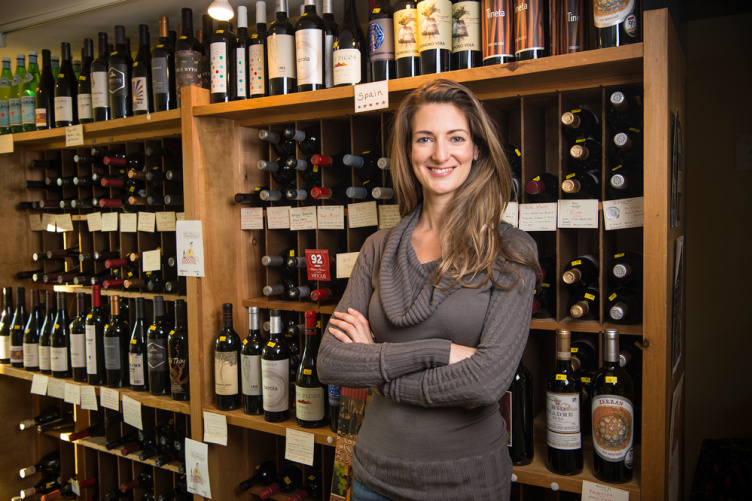
Elizabeth Carter, assistant professor of political science, at South Street & Vine wine shop in Portsmouth, N.H. Photo Credit: Perry Smith Photography
’Tis the season for planning holiday parties, and as you make your shopping list and check it twice, it’s also worth thinking about why you’re choosing a particular wine, cheese or other seasonal treat. Are you the sort of host who springs for the most expensive wine to serve with dinner? Do you gravitate toward fresh ingredients when preparing a holiday meal? Or do you entertain using whatever is available most cheaply and easily?

For Elizabeth Carter, assistant professor of political science and coordinator for the sustainability politics and policy certificate program, those choices each say something about us — and how and why food and drink make it to our tables. Carter’s research focuses on the politics, sociology and economics behind food, as well as fashion and music. That diverse array of influences is most apparent when it comes to wine. Whether it’s being served at a party or given as a gift, each bottle of wine carries with it a complex economic, social and political story.
Imagine for a moment that you’re deciding between two bottles of chardonnay, one from France and one from California’s Napa Valley. Though they’re the same kind of wine, the differences in production and distribution are pronounced.
For French winemakers, “every single thing about the production process is regulated,” says Carter, who studied wine markets in France and Italy. Winemakers in certain regions are allowed only to make certain wines with certain grapes. As Carter explains, when the 2004 film “Sideways” sent novice wine drinkers in search of pinot noir, it was a boon for winemakers in Burgundy, but producers in Bordeaux and other regions couldn’t make pinot noir and respond to the demand. There are no such regulations in the U.S. “You can plant any grape you want and blend it in any way you want,” Carter says. There are some restrictions — a wine made in New Hampshire can’t call itself a Napa Valley wine, for example — but otherwise, winemakers are free to make whatever wine they want.
French regulations allow growers who provide the grapes, producers who make the wine and wine merchants to evenly share economic power — and a stake in the final product. Everyone bands together under a shared brand. And that’s when the economics of the wine market blend with sociology, Carter says.
Enter terroir: the idea that climate, soil, topography and dozens of other characteristics all impart a unique flavor and taste to each wine. “There’s this idea about a ‘dream of the land,’” Carter says. “If you drink a Bordeaux from 1945, then in that moment, you are in Bordeaux in 1945. There’s some kind of magical quality that can be represented by the wine.” This idea, coupled with the fact that the French model naturally limits how much wine producers can make, transforms French wines into a status symbol. Drinking the “right” wine shows someone is “a person of culture and education,” according to Carter. And that makes the wine more expensive.

Even in the U.S., where the lack of regulations gives producers more latitude, pricing and status go hand in hand.
“You determine prices often by what another producer charges,” Carter says. “So if I think my wines are a little better than someone else’s, I’ll price it a few dollars higher to signal that.”
But buying wine and other foods based on price alone won’t always guarantee quality. Carter points to olive oil as an example. Many oils labeled as “Italian extra virgin olive oil” are “not Italian, not extra virgin and not made from olives,” according to Carter. “Those olives do not need to have come from Italy to say that the oil is Italian on the label — there just needs to have been one phase of production in Italy. It’s usually a blend of different oils,” Carter says.
What’s a host to do when confronted with these choices? How does a foodie get the best possible ingredients? For Carter, the answer is twofold. As more communities embrace the Slow Food movement and emphasize buying locally, consumers are positioned to become better educated about where their food comes from, what’s in it and who’s making it. And as consumers become more invested in this knowledge, Carter says farmers and other producers have more incentive to band together — not unlike the French winemakers. All of those factors take a backseat when it comes to individual taste, but even that is shaped by culture, class and other attributes.
In the end, Carter says, “you like what you like.” Whatever you choose might make for a fascinating conversation after dinner — just make sure you’re serving the right dessert.
-
Written By:
Larry Clow '12G | UNH Cooperative Extension
















































